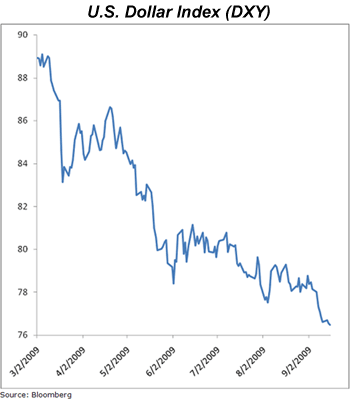Easy-Money Fed Fueling U.S. Dollar “Carry Trades”
Interest-Rates / US Dollar Sep 18, 2009 - 08:10 AM GMTBy: Mike_Larson
 A fascinating thing just occurred in the global interest rate market: For the first time since 1993, it became cheaper to borrow dollars than Japanese yen! The three-month dollar-based London Interbank Offered Rate, or LIBOR, slumped to 0.292 percent, compared with the yen-based LIBOR rate of 0.352 percent.
A fascinating thing just occurred in the global interest rate market: For the first time since 1993, it became cheaper to borrow dollars than Japanese yen! The three-month dollar-based London Interbank Offered Rate, or LIBOR, slumped to 0.292 percent, compared with the yen-based LIBOR rate of 0.352 percent.
I know. You’re thinking: “Who the heck cares?” But this development is big — and so are the potential implications. It’s all because of something called the “carry trade,” which I’m going to get into right now …
The Carry Trade Explained …
Let’s say you’re an international investor looking to boost your returns. One way to do that is to use leverage, or borrowed money. The cheaper you can borrow that money, and the greater the yield you can earn by investing it, the larger your returns. Every single basis point, or 1/100th of a percentage point, less you spend in borrowing costs falls right to your bottom line.
 |
| Carry trade is when global investors borrow in low-yielding currencies and lend in higher-yielding currencies. |
The carry trade is just a global version of this game. Investors seek out the lowest possible short-term funding costs by finding the economy whose central bank is being the most generous. Then they take that money, sell the country’s currency, and invest the funds in currency and asset markets that yield more.
That’s essentially what the world did for ages in Japan. Japan’s twin busts in stocks and real estate caused the country’s central bank to slash interest rates to near zero in the early 1990s. Japan also flooded its economy with trillions of yen in excess cash.
But the money wasn’t used by companies and consumers to spend and invest at home … they were burdened by excess capacity and gun-shy about borrowing after getting burned in stocks and real estate. Instead, the money was used by global investors to fund investments elsewhere.
There was enormous profit to be had in this game because the rest of the global economy did fairly well during Japan’s “Lost Decade.” You could borrow yen at, say, 0.5 percent and invest in places like the U.S. at around 5 percent. It was a veritable gravy train of profits, derailed occasionally by events like the Long-Term Capital Management blow up in 1998.
What the Carry Trade Did to the Yen and Global Markets … And What We May See Happen Here
The mechanics of the carry trade require that you sell the carry currency and buy foreign currencies against it. So one of the side effects is that it depresses the value of the borrowed currency.
Another side effect is that the carry trade helps inflate global asset bubbles.
Last time around, it did this by transporting the excess liquidity being created in Japan to foreign shores.
Now, thanks to the Federal Reserve’s incredibly easy policy stance, we may be in for “Carry Trade Round Two.” Only this time it’s not Japan’s currency that’s being sold relentlessly to fund risky bets …
 |
It’s our dollar!
Look at the chart to the left of the U.S. Dollar Index (DXY), which measures the performance of the greenback against six major world currencies (the euro, yen, British pound, Canadian dollar, Swedish krona, and Swiss franc). It looks like a ski slope, pointing down and to the right.
Unfortunately for dollar-based consumers (that’s us!), the falling dollar has side effects. It drives up the cost of imports, raising our cost of living. It also boosts the price of commodities like gold and oil. And it means the cost of travelling abroad goes up, too.
However, you can actually PROFIT from the trend by socking money away in contra-dollar plays. That includes natural resource stocks, gold, and foreign short-term bonds and stocks. If you want to know more, I urge you to check out my colleague Larry Edelson’s blog. He’s got some great information for you there.
Until next time,
Mike
This investment news is brought to you by Money and Markets . Money and Markets is a free daily investment newsletter from Martin D. Weiss and Weiss Research analysts offering the latest investing news and financial insights for the stock market, including tips and advice on investing in gold, energy and oil. Dr. Weiss is a leader in the fields of investing, interest rates, financial safety and economic forecasting. To view archives or subscribe, visit http://www.moneyandmarkets.com .
Money and Markets Archive |
© 2005-2022 http://www.MarketOracle.co.uk - The Market Oracle is a FREE Daily Financial Markets Analysis & Forecasting online publication.



